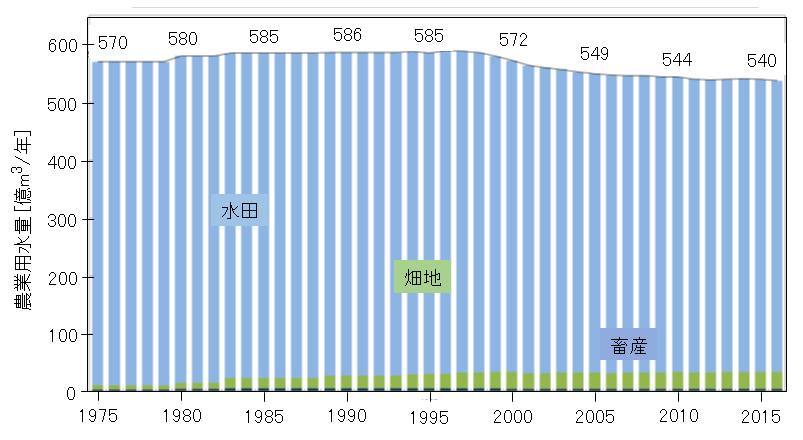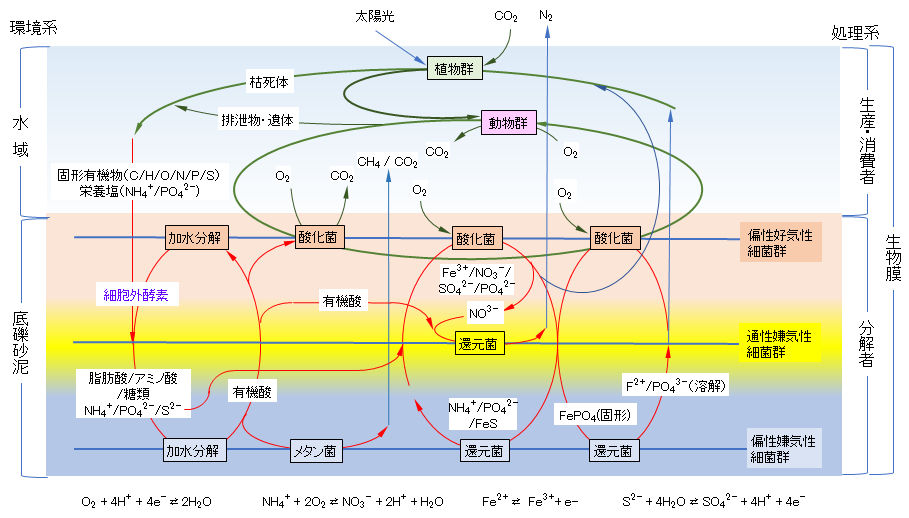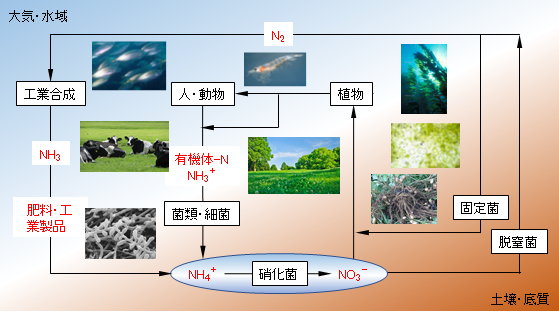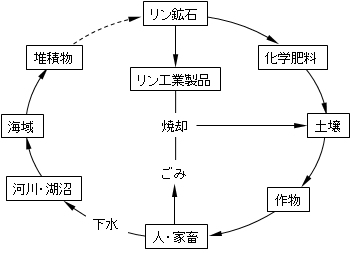Agricultural water and environmental influence in Japan
村上定瞭(水浄化フォーラム), Sadaaki Murakami (Water & Solutions Forum)
2.水田の窒素・リン収支
・窒素・リン収支の概念
・水田からの窒素流出
・畑・樹園地からのリン流出
3.農地の水質浄化機能
・農地機能の総合評価
・多様な生態系の形成
・水質浄化機能の利用
4.農地発生の環境負荷の削減対策
・施肥量の削減
・肥料の種類
・施肥法の改善
・栽培法の改善
・適正な水管理
引用文献
注意)本ページでは本・他サイトのページへリンクしているが、それらの内容の掲載年などの理由により、具体的なデータや数値が異なっていることに留意されたい。また、編集中であり、加筆・訂正・削除等があるので、更新日に留意されたい。
2. Nitrogen and phosphorus balance of paddy field
・Concept of nitrogen and phosphorus balance
・Nitrogen outflow from paddy field
・Phosphorus outflow from farming field and garden
3. Water purification function of farmland
・Comprehensive evaluation of farmland function
・Formation of various ecosystems
・Water purification function
4. Measures to reduce environmental load caused by farmland
・Reduction of fertilizer application
・Type of fertilizer
・Improvement of fertilizer application method
・Improvement of cultivation method
・Proper water management
References
Note) This page links to pages of this and other sites, but please note that the specific data and numerical values may differ due to the year of publication of these contents. Also, please note the date of update as it is being edited and there are corrections, corrections, deletions, etc.
1.農業の水利用
日本の湖の面積は約2,300km2であるのに対し、水田のたん水は25,600km2(1998年)であり、灌漑期間に達すると、一度に10倍以上のたん水面積が広がる。日本の内陸水循環は、国土の66%を占める森林と8%の水田が特徴である。
日本の総水使用量915億m3(1992年)のうち、農業用水の取水量は586億m3であり、そのうち95%以上の559億m3は水田灌漑水、畑地灌漑水は22億m3、家畜用水は5億m3である[国土交通省、1995年]。水田は日本で最大の水利用者である。しかし、水の使用量を正確に把握することは困難である。水田の日減水深が20mm、取水日数が105日、様々な損失(送水中の蒸発、漏水、水位を維持するための水量など)が15%の場合、必要な水量は2,415mmとなる。灌漑期間中の実効降雨量(5〜80mmの1日の総降雨量の80%)は約400mmであるので、これを除けば約2,000mm(560億m3)の取水量になる。上記の水田かんがい用水559億m3は、時期別と地域別で計算することにより算出される。
稲作期の水面蒸発散量を除いた正味の水消費量は平均4.9mm、総量は136億m3であり、その80%を有効降水量だけで賄うことができる。したがって、総取水量に近い500億m3以上の水が何らかの形で水システムに戻ってきていることとなる。このことは、日本の内陸水質への水田の影響は無視できないこととなる。
現代の農業廃水の水質問題は、次の3つに要約できます。 1つは灌漑農業への水質汚濁の影響、2つ目は農地からの汚濁負荷の発生、3つ目は水循環経路に農地が存在することによる水質浄化現象である。第一は本サイトの別ページで記載し、ここでは第2および第3の問題について説明する。
1. Agricultural water use
The lake area in Japan is about 2,300 km2, whereas the water-filled area of paddy fields is 25,600 km2 (1998), and when the irrigation period is reached, the watered area spreads more than 10 times at once. Japan’s inland water cycle is characterized by forests covering 66% of the land area and 8% paddy fields.
Of Japan’s total water consumption of 91.5 billion m3, the agricultural water intake amounted to 58.6 billion m3, of which 95% or more, 55.9 billion m3, was paddy field irrigation water, upland field irrigation water was 2.2 billion m3, and livestock water was 500 million m3 (1992) [MLIT, 1995]. Paddy fields are the largest water users in Japan. However, it is difficult to accurately grasp the amount of water used. If the paddy field daily reduction depth is 20 mm, intake days are 105 days, and various losses (evaporation during water transfer, water leakage, water volume for maintaining water level, etc.) are 15%, the required water volume is 2,415 mm. Since the effective rainfall during the irrigation period (80% of the total amount of daily rainfall from 5 to 80 mm) is about 400 mm, if this is excluded, the total required water intake will be about 2,000 mm (56 billion m3 ). The above-mentioned paddy field irrigation water of 55.9 billion m3 is calculated by performing such calculations by time and region.
Net water consumption that leaves the water surface evapo-transpiration in rice period is an average 4.9 mm, the total amount is 13.6 billion m3, and so 80% of that can be covered by effective rainfall alone. Therefore, more than 50 billion m3 of water, which is close to the total water intake, is returning to the water system in some way or another. This means that the impact of paddy fields on the quality of inland water in Japan cannot be ignored.
The water quality problem of modern agricultural wastewater can be summarized into the following three. The first is the effect of water pollution on irrigated agriculture, the second is the occurrence of pollution load from agricultural land, and the third is the water purification phenomenon due to the existence of agricultural land in the water circulation path. List on a separate page of this site. Here, the second and third problems will be described.

図1 日本の農業用水の推移 [国土交通省: website-水資源の利用状況, 2020]
Fig.1 Transition of Japanese agricultural water [MKIT(Ministry of Land, Infrastructure, Transport and Tourism): website-Water resource usage status, 2020]
目次へ To table of contents
2.農地の窒素・リン収支
2.1 窒素・リン収支の概念
農地の物質収支の経路は、水の出入りに伴う負荷とそうでないものがある。水の出入りに伴う負荷としては、流入は降水・地表流入水(表面灌漑水を含む)と地下流入水(地下灌漑永を含む)であり、流出は表面流出・中間流出・地下浸透である。水の出入りを伴わない収支としては、収入は肥料・農薬・種苗などによる搬入、化学的または生物的固定および乾性降下物であり、支出は収穫・除草などによる搬出、化学的または生物的な大気への放出および風食である。これらの各項と収支残高としての土壌残留量を実際の農地で正確に計量することは困難である。現時点では、農地からの水に伴う流出負荷を問題にする場合には、生物化学的な固定と放出はほぼ等量で平衡していることを前提として、水の出入りに伴う流入・流出負荷と水の流入を伴わない最大の負荷である施肥量だけを論議の対象にしている。
このような場での水収支に伴う物質収支を、把握可能な経路だけに制限して解析評価する手法がラインメータ試験である。しかし、ラインメータでは自然の農地での水収支が完全には再現できない。そこで自然の圃場条件で物質収支を把握しようとする試みが数多く行われてきた。農地からの排出を問題にする場合のいくつかの用語の定義を以下に示す。
排出負荷量= 地表排出負荷量 + 浸透排出負荷量
差引き排出負荷量= 排出負荷量 – 流入負荷量
溶脱率 = 浸透排出負荷量/施肥量
2. N and P balance of farmland
2.1 Concept of N and P balance
There are some routes of material balance of farmland, one is the load associated with the entry and exit of water, and the other is not. The inflows are precipitation / surface inflow water (including surface irrigation water) and underground inflow water (including underground irrigation water), and outflow is surface outflow / intermediate outflow / underground infiltration. As for the balance without water in and out, income is carried in by fertilizers, pesticides, seeds, etc., chemical or biological fixation and dry fall, and expenditure is carried out by harvesting, weeding, etc., chemical or biological atmosphere. Release to and wind erosion. It is difficult to accurately measure each of these items and the residual soil amount as the balance of balance in actual farmland. At present, when considering the outflow load associated with water from farmland, assuming that biochemical fixation and release are almost equilibrium, the inflow and outflow loads associated with water inflow and outflow are assumed. Only the amount of fertilizer application, which is the maximum load without water inflow, is the subject of discussion.
The line meter test is a method for analyzing and evaluating the material balance associated with the water balance in such a place by limiting it to only the routes that can be grasped. However, a line meter cannot completely reproduce the water balance in a natural farmland. Therefore, many attempts have been made to grasp the material balance under natural field conditions. The following are definitions of some terms when the emission from agricultural land is a problem.
Emission load = Surface discharge load + Infiltration discharge load deduction
Emission load = Emission load – Inflow load
Leach rate = Infiltration discharge load / Fertilization amount
2.2 水田からの窒素・リン流出
日本の農地の約半分の面積を占める水田では、啼渠排水が広く行われるようになり、浸透水が量的にも質的にも把握しやすく、また、水田の立地条件では暗渠より下方への浸透は無視できるほど少ない場合が多い。したがって、水田での物質収支を検討したデータは比較的多く集められている。これまでにいろいろな規模の水田で行われた 60例ほどの流入量(灌漑水と降水に由来する)と流出量(表面排水と地下浸透による)を比べた結果を表1に示した。かなり変動の幅が大きいが単純平均では、流入量に比べて流出量は、窒素では両者はほとんど同じであり、リンでは後者かわずかに少ない。つまり水田は通過する水に対して見掛け上、窒素とリンに関してはほとんど汚濁も浄化もしていないことになる。また一方、水田に流入する水の汚濁の程度が高ければ浄化される負荷量が多くなり、反対に汚濁されていない水を灌漑した場合には、流出水はむしろ多少汚濁する。
千葉県下の41箇所の水田で行われた調査では、流入水中の濃度で窒素では 2mg/L以上、リンでは 0.24mg/L以上の場合に水田の浄化機能が働き、それ以下では水田は汚濁源になることが明らかにされている[森川, 1984]。全国の農業用水の平均窒素濃度は1.3m/L程度で、流入濃度が2mg/Lを超える水田は約20%と推定されているので[農林水産省, 1994]、水田は平均的には汚濁源としての性格の方が強いことになる。
2.2 N and P outflow from paddy fields
Paddy fields, which occupy about half the area of Japanese farmland, are now being widely drained, making it easier to understand the infiltration water both quantitatively and qualitatively. Penetration is often negligible. Therefore, a relatively large amount of data has been collected on the material balance of paddy fields. Table 1 shows the results of comparing the inflow (due to irrigation water and precipitation) and outflow (due to surface drainage and underground infiltration) of about 60 cases that have been carried out in paddy fields of various scales. Although there is a wide range of fluctuations, in the simple average, the outflow rate is almost the same for nitrogen and the latter is slightly less for phosphorus than the inflow rate. In other words, the paddy field apparently does not pollute or purify nitrogen and phosphorus with respect to the passing water. On the other hand, if the degree of pollution of water flowing into the paddy field is high, the amount of load to be purified increases, and conversely, when irrigating uncontaminated water, the effluent water is rather polluted.
According to a survey conducted at 41 paddy fields in Chiba Prefecture, when the concentration of inflow water was 2 mg/L or more for nitrogen and 0.24 mg/L or more for phosphorus, the paddy field purification function worked, and below that level, the paddy fields became polluted. It has been clarified to be a source [Morikawa, 1984]. The average nitrogen concentration in agricultural water nationwide is about 1.3 m/L, and it is estimated that about 20% of paddy fields have an inflow concentration of more than 2 mg/L [MAFF, 1994]. The personality will be stronger.
表1 水田における物質収支 [関矢, 1987] [kg/ha/y]
Table 1. Materials-balances in Paddy Fields in Japan [Sekine, 1987] [kg/ha/y]

2.3 畑・樹園地からの窒素・リン流出
畑や樹園地の場合は日本では灌漑が行われる面積がわずかであるので、水の流入は降水だけである。流出は多量の降雨や積雪地の雪解け時には表面流出が起こるが、通常は地下浸透が主体である。ライシメータ以外ではこの地下浸透を正確に把握することは不可能である。いままで実際の畑地で、この地下浸透量を測定した例は、たまたま水文的に地下の水動態が解析できた茨城県農業試験場の35haの畑圃場(淡色黒ポク土)における研究事例だけである。ここでは7年間の平均で、年間窒素施肥量52.6kg/ha、雨水と地下水からの窒素供給量 24.9kg/haに対して35.5kg/ha の流出が測定され、無肥料区との差引きで求められた施肥窒素の溶脱率は 20~25 %で、明らかに畑地の汚濁源としての性格を示した[小川, 1984]。
目次へ
2.3 N and P outflow from fields and orchards
In the case of fields and orchards, the inflow of water is only precipitation, as the area of irrigation is small in Japan. Surface runoff occurs when a large amount of rainfall or snow-melt occurs in the snowy area, but the main cause is usually underground infiltration. Except for the lysimeter, it is impossible to accurately grasp this underground infiltration. Up to now, the only example of measuring this amount of subsurface infiltration in an actual field was a case study in a 35 ha field field (light black andosol) at the Ibaraki-Ken Agricultural Experiment Station, where it was possible to hydrologically analyze underground water dynamics. Here, on average for 7 years, the annual nitrogen fertilizer application rate was 52.6 kg/ha, and the nitrogen supply rate from rainwater and groundwater was 24.9 kg/ha, and the outflow of 35.5 kg/ha was measured. The required leaching rate of fertilized nitrogen was 20 to 25%, clearly showing the character as a source of pollution in the field [Ogawa, 1984].
Table of contents
3.農地の水質浄化機能
3.1 農地機能の総合評価
水田ではその還元的な土層中で硝酸を脱窒する現象があるので窒素については浄化能があるはずであり、水田が汚濁源となるのは肥料が無駄に流出しているからである。施肥と水管理の方法を改善することによって本来の浄化機能を取り戻すことは可能である。実際に被覆肥料などの低拡散性肥料の使用、施肥田植同時作業機による側条施肥など肥料の流出を抑制する技術が定着しつつある。
畑については日本の降雨条件では基本的に肥料の溶脱が起こることは避けられない。一定の生産を確保するためには肥料流出は避けられないとさえ考えられる。しかし、ここでは農地の水質浄化機能は浄化槽モデルとは異なるということに注意すべきである。そこに農地が存在しなければ直接・間接的に水域に負荷される汚濁負荷を水の流入を伴わず農地が引き受けている分がある。家畜ふん尿・汚泥・パークなどの有機性廃棄拡の農業利用である。これらの資材は水田より畑で多く用いられる。畑土壌は有機物を分解し無機化する作用が強い。このことからBOD、CODの削減に貢献していることになる。
農地のもつ水質浄化機能を定量的に評価するには、実際の河川流域について物質動態モデルを構築して、流域に存在するそれぞれの土地利用からの流出負荷の水質への寄与を明確にしなければならない。しかし、水文的にまとまりをもった大流域では、そこでの人間活動に伴う物質収支や流域内コンパートメント間の移動貯留を正確に計量するのはかなりの困難である。さらにモデルを実証するためには、環境条件の異なる多数の実測可能な流域を設定してデータを集める必要がある。
3. Water purification function of farmland
3.1 Comprehensive evaluation of farmland functions
In the paddy field, there is a phenomenon of denitrifying nitric acid in the reductive soil layer, so it should have the ability to purify nitrogen. It is possible to restore the original purification function by improving the method of fertilization and water management. In fact, technologies for controlling the outflow of fertilizers such as the use of low-diffusion fertilizers such as coated fertilizers and side-row fertilization by a fertilizer application planter are becoming established.
Regarding fields, it is inevitable that fertilizer leaching basically occurs under the rainfall conditions in Japan. It is even considered that fertilizer runoff is unavoidable in order to secure constant production. However, it should be noted here that the water purification function of farmland is different from the septic tank model. If there is no farmland there, there is a portion that the farmland takes on the pollution load directly or indirectly on the water area without inflowing water. It is an agricultural use for expanding organic waste such as livestock excreta, sludge, and parks. These materials are used more in fields than in paddy fields. Upland soil has a strong effect of decomposing organic matter and mineralizing it. This means that it contributes to the reduction of BOD and COD.
In order to quantitatively evaluate the water purification function of farmland, we must construct a material dynamics model for the actual river basin and clarify the contribution of runoff load from each land use existing in the basin to water quality. However, it is quite difficult to accurately measure the mass balance of human activities and the mobile storage between compartments in a large basin that is hydrologically organized. In order to further validate the model, it is necessary to set up a large number of measurable basins with different environmental conditions and collect data.
3.2 多様な生態系の形成
水田の水・物質収支に関する調査研究は進めらている。稲の湛水時期は、春・夏で生物の活動が活発な時期であり、水田には微生物・ミジンコ・昆虫・カエル・鳥類など、多様な生物による食物連鎖系が形成されている。この生態系における物質収支と環境機能に関する量的な調査・解析は行われていないが、水質浄化において重要な役割を果たしていることと推定される。
3.2 Formation of diverse ecosystems
Research and study on the water and mass balance of paddy fields is ongoing. The rice is flooded during spring and summer, when biological activities are active. In the paddy field, a food chain system is formed by various organisms such as microorganisms, daphnia, insects, frogs and birds. Although quantitative research and analysis have not been carried out on the material balance and environmental functions in this ecosystem, it is presumed that it plays an important role in water purification.
3.3 水質浄化機能の利用
上記のように農地のもつ水質浄化機能を広く捉え、農村生活や畜産(飼料生産と連結したもの)を含め農業空間から発生した負荷はすべて農業空間内で処理し再資源化する原則に立つ必要がある。混住化か進んでいる今日では人間活動から排出される有害物の影響をいかに回避するかという困難な問題がある。農業に対して汚濁の質的内容を問わず浄化能を期待することは無理であるが、再利用の影響評価の可能な排水廃棄物については積極的にリサイクルを行うべきである。一方、土壌にもその類型によって潜在的水質浄化機能に差があると考えられる[森川, 1984]。機能利用が可能な土壌類型を水田と畑の土地利用別に示せば表2のようである。
目次へ
3.3 Use of water purification function
As described above, it is necessary to broadly understand the water purification function of agricultural land, and follow the principle that all the load generated from agricultural space, including rural life and livestock (connected to feed production), is processed and recycled in agricultural space. In today’s increasingly mixed-living world, there is the difficult problem of how to avoid the effects of harmful substances emitted from human activities. It is not possible to expect the ability of agriculture to purify irrespective of the qualitative content of pollution, but wastewater waste that can be evaluated for the impact of reuse should be actively recycled. On the other hand, it is considered that there is a difference in latent water purification function depending on the type of soil [Morikawa, 1984]. Table 6.2 shows the types of soil that can be used for each function, depending on the land use of paddy fields and fields.
To table of contents
Table 2. Water purification applicable soils by farmland use [Masujima, 1990]

4.農地発生の環境負荷の削減対策
4.1 施肥量の削減
肥料は本来、目標とする収量、品質を得るために必要な作物の養分のうち、土壌などからの天然供給だけでは不足する分を補うために施用するものである。したがって施肥量は、作物の種類・品種・土壌条件・気象条件・栽培様式などによって異なるもので、各都道府県において標準となる施肥基準を策定し、情勢の変化に対応して見直しが行われている。また最近は、土壌診断や作物の栄養診断技術の進歩により、より精密な施肥量の決定も可能になってきた [藤原, 2013;武田, 2002]。
特に施肥が水環境におよぼす影響が問題にされている現在、土壌からの窒素・リン流出による汚染防止対策として、施肥量の適正化はいっそう重要度を増している。一般に施肥量が増すに従って流出量は増すと考えられ、作物吸収量以上の施肥を行わない管理方法が必要である。家畜ふんの多用による地下水汚染が深刻な問題になっているEUでは、当面窒素施用量の限度を年間 200 kg/ha 以下とし、2000年以降は160 kg/ha にまで引き下げることが合意されている。
4. Measures to reduce environmental impact of farmland
4.1 Reduction of fertilizer application
The fertilizer is originally applied to supplement the nutrients of the crop necessary for obtaining the target yield and quality, which are insufficient by natural supply from the soil. Therefore, the amount of fertilizer applied varies depending on the type of crop, variety, soil conditions, weather conditions, cultivation style, etc. Therefore, standard fertilization standards have been established in each prefecture, and they have been reviewed in response to changes in the situation. There is. Recently, more advanced fertilizer application rates have become possible due to advances in soil diagnosis and crop nutrition diagnosis technology [Fujiwara, 1996; Takeda, 2002].
At present, when the effect of fertilizer application on the water environment has become a particular issue, it is becoming even more important to optimize the amount of fertilizer application as a measure to prevent pollution due to nitrogen and phosphorus outflow from soil. It is generally considered that the amount of runoff will increase as the amount of fertilizer applied increases, and a management method that does not apply more fertilizer than the crop absorption amount is necessary. In EU countries, where groundwater pollution due to heavy use of livestock manure has become a serious problem, it has been agreed that the nitrogen application limit will be 200 kg/ha or less per year for the time being, and will be reduced to 160 kg/ha after 2000.
4.2 肥料の種類
土壌中に施用してから肥料の効果をなるべく長期間持続させるためにいろいろな形態の肥料がつくられている。
従来の単一のアンモニウム塩や硝酸塩(速効性肥料)に比べて、肥料の分解または溶解の時間を遅らせる工夫をしたもので、主として化学的形態の効果によるもの(イソブチリデン2尿素・グアニル尿素・オキサミドなど)、主として物理的形態の効果によるもの(大型粒状肥料・被覆肥料)がある。これらは土壌水分中への窒素の溶出が遅いので溶脱抑制対策となる。また、リン酸アンモニウム態窒素の溶出率が低いことも認められている。一般に有機質肥料に含まれる窒素は、無機質化学肥料に比べ溶脱率が低い。また、アンモニウムイオンは土壌粒子の負荷電にとらえられて溶脱しにくいが、硝酸に酸化されることによって土壌に補足されずに溶脱することから、硝化抑制剤(ジシアンジアミドが多く使われる)の入った肥料も対策として考えられる。今日のところ、これらの中では被覆肥料が粒の大きさと被覆の種類によって溶出時間を調節することが可能で、溶脱抑制効果が確実であると考えられている。
4.2 Types of fertilizer
Fertilizers of various forms have been produced in order to maintain the effect of the fertilizer as long as possible after being applied to the soil.
Compared to conventional single ammonium salts and nitrates (fast-acting fertilizers), it has been devised to delay the time required for the decomposition or dissolution of fertilizer, mainly due to the effect of its chemical form (isobutylidene diurea, guanylurea, oxamide, etc.), mainly due to the effect of physical form (large granular fertilizer or coated fertilizer). These are measures to suppress leaching because nitrogen elutes slowly into soil water. It has also been confirmed that the elution rate of ammonium phosphate nitrogen is low. Nitrogen contained in organic fertilizers generally has a lower leaching rate than inorganic fertilizers. In addition, ammonium ions are not easily leached due to the negative charge of soil particles, but are leached without being captured by the soil by being oxidized by nitric acid. Fertilizer can be considered as a countermeasure. At present, among these, it is considered that the coated fertilizer can control the elution time depending on the size of the grain and the type of coating, and the leaching suppression effect is certain.
4.3 施肥法の改善
水田の場合、施肥・しろかき後の移植では機械作業の都合から水田の表面水を排除してから移植を行うことになる。このときの排水には多量の肥料成分が溶解しており、流出窒素量が増大する。これを防ぐため移植前には施肥せず、移植作業と同時に土壌中に側条施肥する機械が普及しつつある。これと肥料の種類を組み合わせることによって、水田からの窒素の流出を最少に抑えることができる。
畑地では、施肥時期と流出は深い関係があり、作物に利用され難い時期の施肥は、損失と汚染を招くことになる。一般に、速効性肥料は作物の生育に伴って必要量を分施した方法が利用効率が高い。ニンジンのように栽培期間の長い作物では、分施回数を増すことによって、窒素の利用率は高まり、流出率の低減につながることがわかっている。
4.3 Improvement of fertilization method
In the case of paddy fields, transplanting after fertilization and shaving is performed after removing surface water of the paddy fields because of mechanical work. A large amount of fertilizer components are dissolved in the waste water at this time, and the outflow nitrogen amount increases. To prevent this, machines that do not apply fertilizer before transplantation but apply lateral fertilizer to soil at the same time as transplantation are becoming popular. By combining this with the type of fertilizer, the outflow of nitrogen from paddy fields can be minimized.
In upland fields, fertilization time and runoff are closely related, and fertilization at times when they are difficult to use for crops will cause loss and pollution. In general, a fast-acting fertilizer has a high utilization efficiency when the required amount is divided according to the growth of the crop. It has been known that, for a crop having a long cultivation period such as carrot, increasing the number of times of application increases the utilization rate of nitrogen, which leads to a reduction in the outflow rate.
4.4 栽培法の改善
土壌表面にビニルフィルムを敷くマルチ栽培や雨よけ栽培など、降水を遮断する栽培法では水の浸透が抑えられて、窒素など養分の溶脱も防がれる。葉菜類のような多肥栽培の後作にはクリーニングクロップを入れた輪作体系を取り入れることも負荷低減対策となる。
リンの負荷発生は土粒子に吸着された形(SS)での流出によることが多いので、土壌侵食の防止が対策となる。傾斜地では等高線栽培や急斜面の植生帯の保全が必要である。また新たに造成した農地では、土壌有機物が不足しており、土粒子が分散しやすいので圃場内沈砂池を設置する。しかし、分散した粘土の捕捉は困難である。
4.4 Improvement of cultivation method
In a cultivation method that blocks precipitation, such as mulching cultivation in which a vinyl film is laid on the soil surface and rain protection cultivation, water penetration is suppressed and leaching of nutrients such as nitrogen is also prevented. Introducing a crop rotation system with cleaning crops into the subsequent crops such as leafy vegetables is also a measure to reduce the load.
The phosphorus load is often generated by the outflow in the form of adsorbed soil particles (SS), so prevention of soil erosion is a countermeasure. Contour cultivation and conservation of vegetation zones on steep slopes are necessary on sloping land. In addition, since the soil organic matter is insufficient in the newly created farmland and soil particles are easily dispersed, a sand basin in the field will be installed. However, it is difficult to capture dispersed clay.
4.5 適正な水管理
畑に施用された窒素は、酸化されて硝酸となり、水の降下浸透に伴って下層に浸透する。下層に溶脱された硝酸は、間接流出に伴って水田下層に流入し、還元条件の水田土屑に拡散する。還元土層中では硝酸は脱窒菌によって窒素ガスにまで還元され脱窒する。このとき土壌中の易分解性有機物が電子供与体となる。この自然の脱窒過程を強化して利用することも対策技術として重要である。これまでのデータでは、水田は年間平均で、1日1ha当り1kgの窒素を消失する程度のポテンシャルをもっていると考えられている(灌漑期間の平均では、1日1ha当り6kg 除去された例もある)[楠田, 1994]。
リンに関しては、黒ボク土壌のリン酸吸着力が大きく、施肥量中の未利用リンの大部分は非水溶性の形で土壌中に蓄積され、水質への影響は少ないと考えられる。しかし、土壌のリン酸吸収力を非特定汚染源対策に積極的に利用することは困難である。これ以上のリン除去を期待するとなると、希薄なリンを含む水の畑地灌漑を行うことになり、それは新たな施肥の溶脱をもたらすことになる。日本の畑の表層土壌中にはかなりのリンが蓄積されており、これが侵食によって水域の底質となった場合、水質に回帰するリン源として慟くので、土壌侵食の防止が対策として重要である。
4.5 Proper water management
Nitrogen applied to the field is oxidized to nitric acid, and permeates to the lower layer as water descends. The nitric acid leached to the lower layer flows into the lower layer of the paddy field due to the indirect outflow, and diffuses into the paddy field debris under reducing conditions. In the reduced soil layer, nitric acid is reduced to nitrogen gas by denitrifying bacteria and denitrified. At this time, the easily decomposable organic matter in the soil becomes an electron donor. It is also important as a countermeasure technology to strengthen and utilize this natural denitrification process. According to the data so far, paddy fields are considered to have a potential of erasing 1 kg of nitrogen per 1 ha per day on average on average (in some cases, 6 kg per 1 ha per day was removed on average during the irrigation period). [Kusuda, 1994].
As for phosphorus, it is considered that the phosphate adsorption capacity of andosols is large and most of the unused phosphorus in the fertilizer application amount is accumulated in the soil in a non-water soluble form, and the influence on water quality is small. However, it is difficult to positively utilize the phosphate absorption capacity of soil as a measure against non-specific pollution sources. If further phosphorus removal is expected, field irrigation of water containing dilute phosphorus will be carried out, which will lead to leaching of new fertilization. A considerable amount of phosphorus is accumulated in the surface soil of Japanese fields, and if this becomes the bottom sediment of the water area due to erosion, it will be a source of phosphorus that returns to the water quality, so prevention of soil erosion is an important measure.
4.6 リサイクル農業の推進
畜産廃棄物の農業利用は、最も大切な汚染対策である。しかし、家畜ふん尿は水田では還元害のおそれがある。畑作物でも初期の生育を確保するために、家畜ふん尿に加えて多少の速効性の化学肥料の使用は必要になる。したがって、日本で水域に負荷を与えることなく畜産を継続するためには、家畜ふん尿の流域外への流通利用が必須となる。家畜ふん尿を利用しやすくするためには、他の有機性廃棄物(汚泥、生ごみなど)とともに堆肥化することが望ましい。このため、堆肥の製造や貯蔵に要する場所や労力の確保も問題となる。家畜ふん尿の環境保全的再利用システムの揃立は、閉鎖性水域の水質保全のためには、最も優先順位の高い対策である。
目次へ
4.6 Promotion of recycling agriculture
The agricultural use of livestock waste is the most important measure against pollution. However, livestock manure may cause reducing harm in paddy fields. In field crops, it is necessary to use some fast-acting chemical fertilizers in addition to livestock excreta in order to secure the initial growth. Therefore, in order to continue livestock production in Japan without imposing a load on the water area, it is essential to use the livestock excreta outside the watershed. In order to make livestock manure easy to use, it is desirable to compost it with other organic waste (sludge, garbage, etc.). Therefore, securing a place and labor required for manufacturing and storing compost is also a problem. The establishment of an environment-friendly recycling system for livestock excreta is the highest priority measure for water quality conservation in closed water areas.
To table of contents
1) 森川 正記、他:千葉県農業試験場研究報告、(25)、pp.137-144(1984).
2) 小川 吉雄:火山灰畑地からの肥料成分の流出とその軽減対策に関する研究、東京農業大学学位論文(1984)、p.257.
3) 増島 博: 農村における水質浄化シンポジウム、日本土壌協会 (1990)、 pp.1-5.
4) 農林水産省:農業用水路水質調査(平成3~5年度)結果報告書(1994)、P.23.
5) 楠田 哲也編:自然の浄化機構の強化と制御、技報堂(1994)、pp.53-69.
6) 国土交通省:平成8年版日本の水資源、大蔵省印刷局(1995)、 p.373.
7) 武田 健:新しい土壌診断と施肥設計、農山漁村文化協会(2002)
8) 藤原俊六郎:土壌の基礎知識、農山漁村文化協会(2013)
1) Masaki Morikawa, et al.: Bulletin of the Chiba-Ken Agricultural Experiment Station, 25, pp.137-144 (1984) (in Japanese).
2) Yoshio Ogawa: Study on the outflow of fertilizer components from volcanic ash fields and its mitigation measures, Dissertation (1984), Tokyo University of Agriculture, p.257 (in Japanese).
3) Hiroshi Masujima: Symposium on Water Purification in Rural Areas, Japan Soil Association (1990), pp.1-5 (in Japanese).
4) MAFF; Ministry of Agriculture, Forestry and Fisheries: Report of Water quality survey on agricultural irrigation canal in Japan (FY1991 to FY1993) (1994), p.23 (in Japanese).
5) Tetsuya Kusuda, ed.: Strengthening and Controlling Natural Purification Mechanism, Gihodo (1994), pp.53- 69 (in Japanese).
6) MLIT; Ministry of Land, Infrastructure, Transport and Tourism: 1996 Water Resources of Japan, Ministry of Finance and Printing Bureau(1995), p.373 (in Japanese).
7) Ken Takeda: New soil diagnosis and fertilization design, Rural Culture Association Japan(2002) (in Japanese)
8) Shunrokurou Fujiwara: Basic knowledge of soil, Rural Culture Association Japan(2013) (in Japanese)
本サイト内の窒素・リンの循環に関する画像
Illustration of the circulation of nitrogen and phosphorus in this site

図 自然界の生態系による物質循環と生物膜の理解モデル
Figure Model for understanding material cycle and biofilm by ecosystem in nature

図 窒素の循環
Figure Nitrogen circulation

図 リン鉱石からのリンの循環
Figure Phosphorus circulation from phosphate ore
更新日:2020年07月01日
Updated: July 01, 2020.
